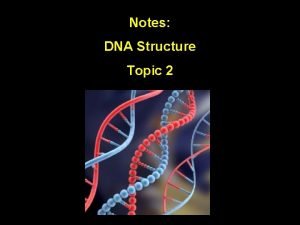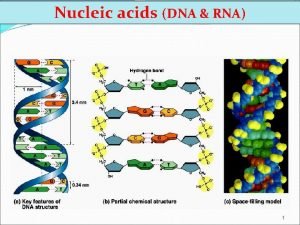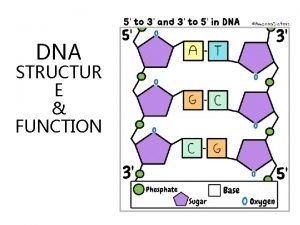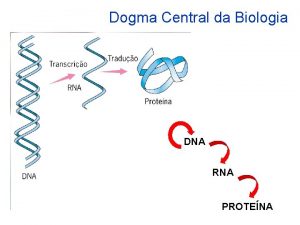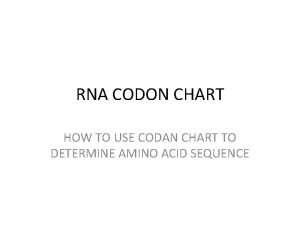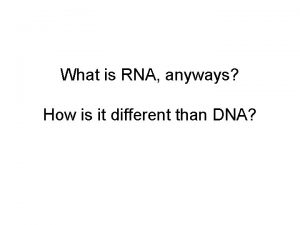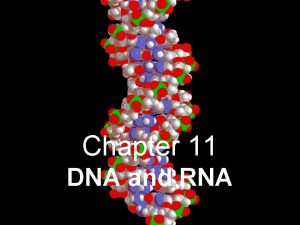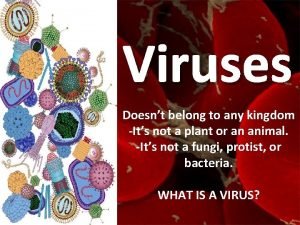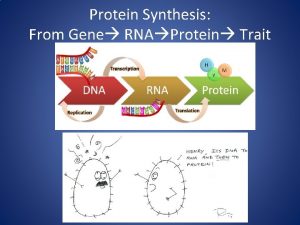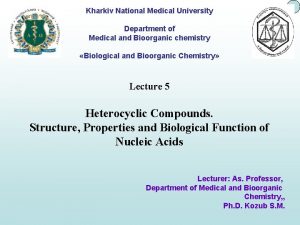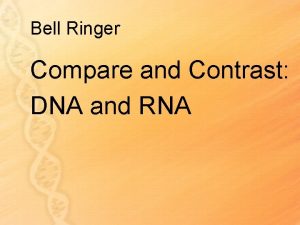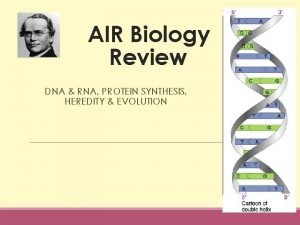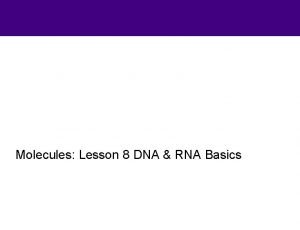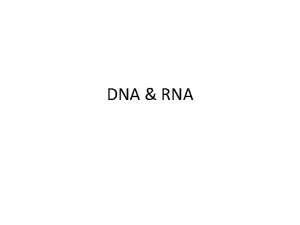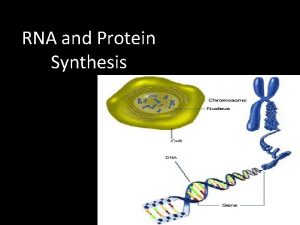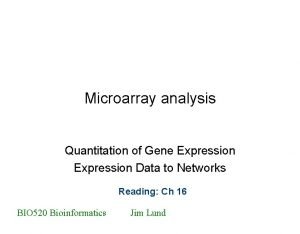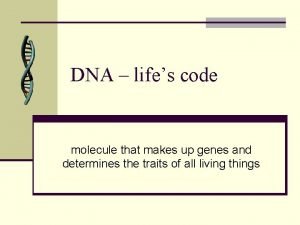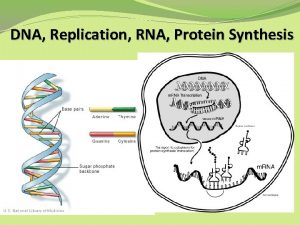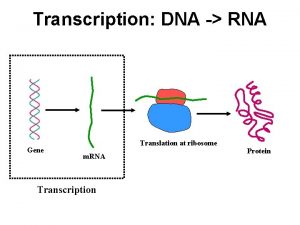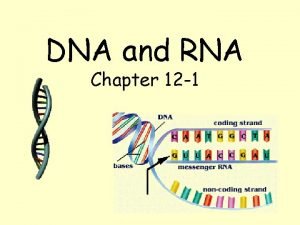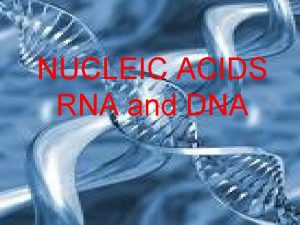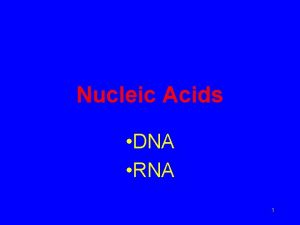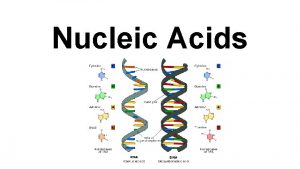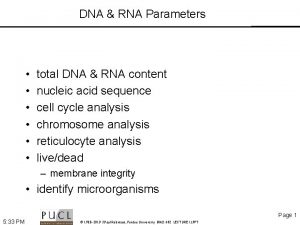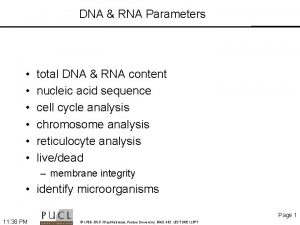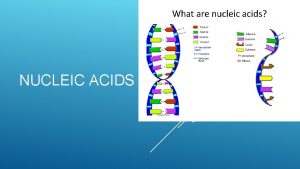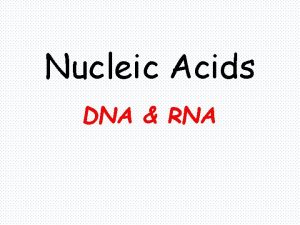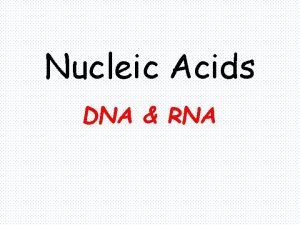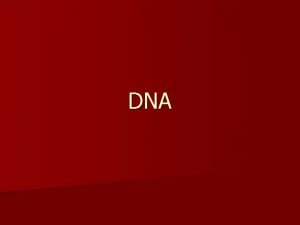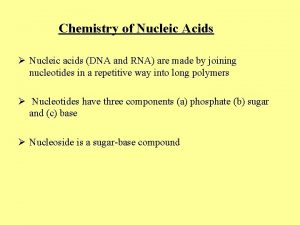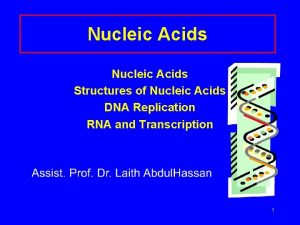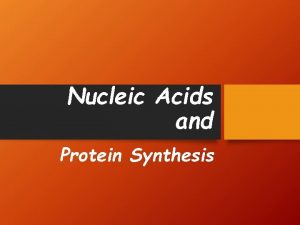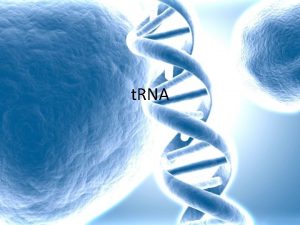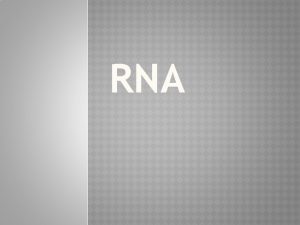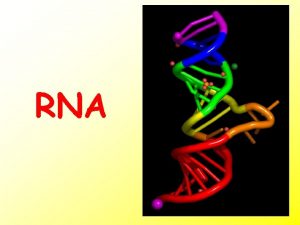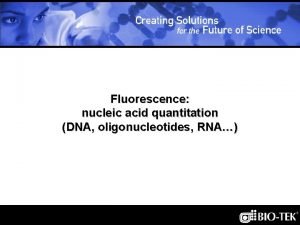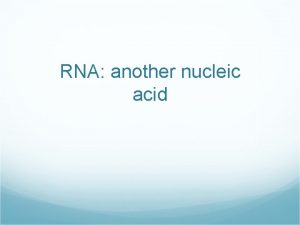Nucleic Acids DNA RNA Nucleic Acids Nucleic acids


























- Slides: 26

Nucleic Acids DNA & RNA

Nucleic Acids • Nucleic acids are molecules that store information for cellular growth and reproduction • There are two types of nucleic acids: - deoxyribonucleic acid (DNA) and ribonucleic acid (RNA) • These are polymers consisting of long chains of monomers called nucleotides • A nucleotide consists of a nitrogenous base, a pentose sugar and a phosphate group:

Nucleic Acids DNA and RNA are nucleic acids, long, thread-like polymers made up of a linear array of monomers called nucleotides All nucleotides contain three components: 1. A nitrogen heterocyclic base 2. A pentose sugar 3. A phosphate residue

Chemical Structure of DNA vs RNA Ribonucleotides have a 2’-OH Deoxyribonucleotides have a 2’-H

Pentose Sugars • There are two related pentose sugars: - RNA contains ribose - DNA contains deoxyribose • The sugars have their carbon atoms numbered with primes to distinguish them from the nitrogen bases

Nucleotide Function Building blocks for DNA and RNA Intracellular source of energy - Adenosine triphosphate (ATP) Second messengers - Involved in intracellular signaling (e. g. cyclic adenosine monophosphate [c. AMP]) Intracellular signaling switches (e. g. G-proteins)

• It is the order of these base pairs that determines genetic makeup • One phosphate + one sugar + one base = one nucleotide • Nucleotides are the building blocks of DNA – thus, each strand of DNA is a string of nucleotides

Sanger dideoxy sequencing incorporates dideoxy nucleotides, preventing further synthesis of the DNA strand

base(purine、pyrimdine)+ribose(deoxyribos glycosyl linkage nucleoside+phosphate phosphoester linkage nucleotide phosphodiester linkage N-


Nucleotide Structure - 1 Sugars HOCH 2 Generic Ribose Structure OH O Ribose 5’ HOCH 2 O OH 4’ OH 1’ 3’ 2’ HOCH 2 OH O N. B. Carbons are given numberings as a prime Deoxyribose OH H

Purine and Pyrimidine • Pyrimidine contains two pyridine-like nitrogens in a sixmembered aromatic ring • Purine has 4 N’s in a fused-ring structure. Three are basic like pyridine-like and one is like that in pyrrole

Nucleotide Structure - 2 Bases - Purines NH 2 N Adenine N A N N 6 7 5 9 4 8 N 3 N H 1 N O 2 N N Guanine NH G N H N NH 2


Nucleotide Structure - 3 Bases - Pyrimidines O Thymine H 3 C NH N 4 3 5 2 6 1 N T O H NH 2 N N Cytosine C N H O



Nitrogen Bases • The nitrogen bases in nucleotides consist of two general types: - purines: adenine (A) and guanine (G) - pyrimidines: cytosine (C), thymine (T) and Uracil (U)

Nucleotide Structure - 4 Bases - Pyrimidines Thymine is found ONLY in DNA. In RNA, thymine is replaced by uracil Uracil and Thymine are structurally similar Uracil 4 3 5 2 6 1 N O N NH N H U O

Nucleotide Structure - 4 Base-Sugar-PO 424 3 2 O O P O O 1 N 5’ C O 4’ 1’ 3’ 2’ OH Monophosphate 5 N 6

Nucleotide Structure - 4 Phosphate Groups Phosphate groups are what makes a nucleoside a nucleotide Phosphate groups are essential for nucleotide polymerization Basic structure: O O P O O X

Nucleotide Structure - 4 Phosphate Groups Number of phosphate groups determines nomenclature Monophosphate e. g. AMP Free = inorganic phosphate (Pi) Diphosphate e. g. ADP Free = Pyrophosphate (PPi) O O P O CH 2 O O P O O CH 2

Nucleotide Structure - 4 Phosphate Groups Triphosphate e. g. ATP O No Free form exists O O P O O CH 2

Nucleosides and Nucleotides • A nucleoside consists of a nitrogen base linked by a glycosidic bond to C 1’ of a ribose or deoxyribose • Nucleosides are named by changing the nitrogen base ending to -osine for purines and –idine for pyrimidines • A nucleotide is a nucleoside that forms a phosphate ester with the C 5’ OH group of ribose or deoxyribose • Nucleotides are named using the name of the nucleoside followed by 5’-monophosphate

Names of Nucleosides and Nucleotides

AMP, ADP and ATP • Additional phosphate groups can be added to the nucleoside 5’monophosphates to form diphosphates and triphosphates • ATP is the major energy source for cellular activity
 Chapter 11 dna and genes
Chapter 11 dna and genes Nucleic acid dna structure
Nucleic acid dna structure Dna structure labeled diagram
Dna structure labeled diagram Nucleic acid
Nucleic acid Nucleic acid dna structure
Nucleic acid dna structure Oq é biologia molecular
Oq é biologia molecular Aug amino acid
Aug amino acid Nucleotide in rna
Nucleotide in rna Chargaff
Chargaff What does dna have that rna doesnt
What does dna have that rna doesnt Venn diagram rna and dna
Venn diagram rna and dna Fraction
Fraction Rna types
Rna types Dna rna protein trait
Dna rna protein trait Pentose sugar structure in dna
Pentose sugar structure in dna Dna vs rna
Dna vs rna Corona virus dna or rna
Corona virus dna or rna Compare and contrast dna and rna.
Compare and contrast dna and rna. Dna double helix coloring worksheet answer key
Dna double helix coloring worksheet answer key Rnabases
Rnabases Frederick griffith transformation
Frederick griffith transformation Venn diagram of dna and rna
Venn diagram of dna and rna Microarray analysis
Microarray analysis What is the goal of replication
What is the goal of replication Lenine
Lenine Ribosomem
Ribosomem On and off
On and off


